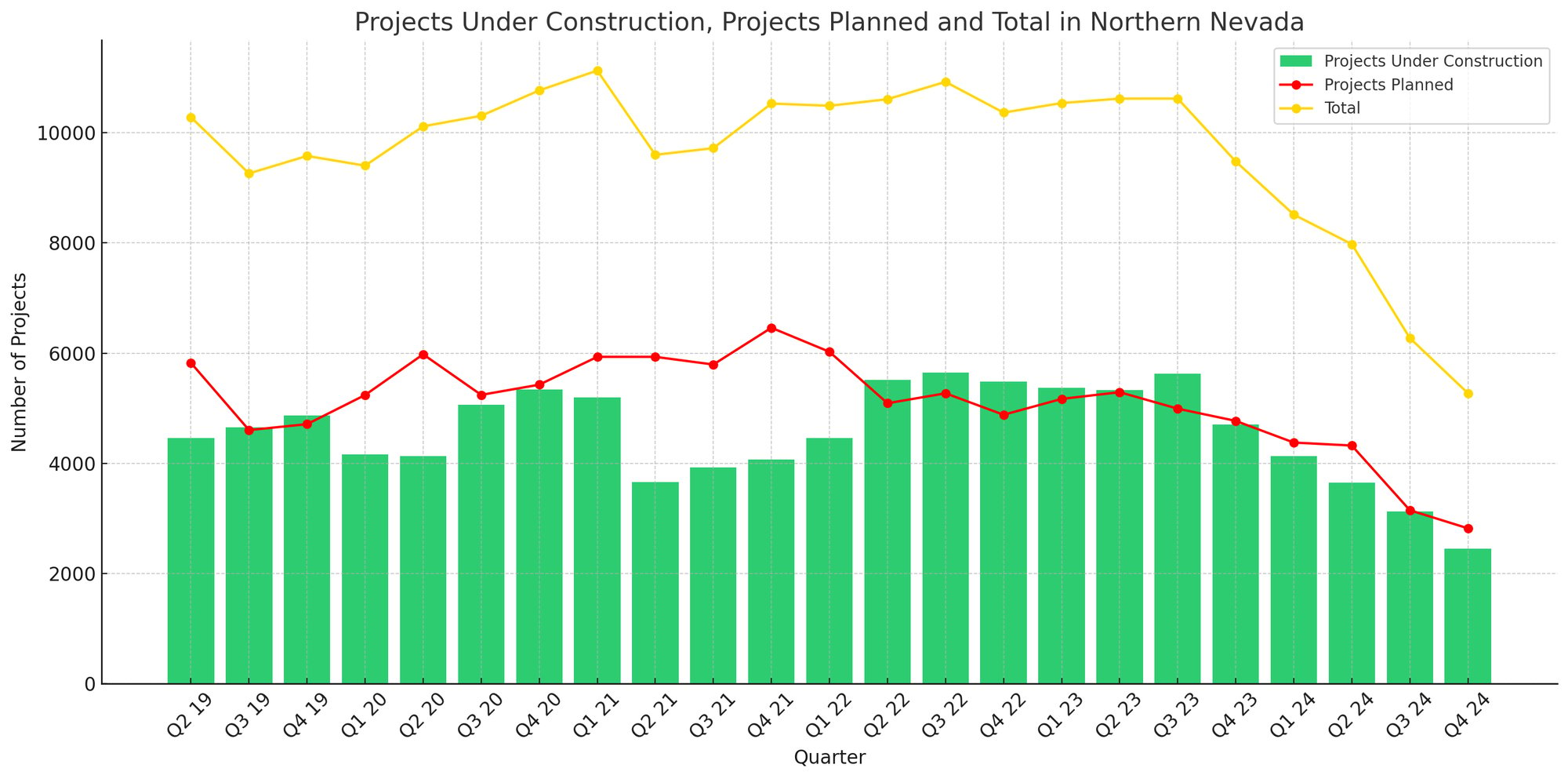Reno’s Multifamily Pipeline Is Drying Up—Here’s Why It Matters
.jpg?width=50&name=DZ9A5684%20(1).jpg) By
Jake Andronico
·
2 minute read
By
Jake Andronico
·
2 minute read

Northern Nevada's Multifamily Construction Pipeline Is Drying Up Fast: What This Means for the Reno Market
If you’ve been tracking Northern Nevada’s multifamily pipeline, the latest numbers paint a clear picture—and it's not a pretty one. The number of projects under construction, planned, and total has dropped significantly since 2022. For Reno, this isn’t just a development story—it’s a rent growth and supply-demand story in disguise.
Let’s break it down and look at what this means for developers, investors, and renters.
Multifamily Starts Are Collapsing in Reno—Here’s the Proof
Just two years ago, Northern Nevada was humming along with more than 10,000 total multifamily units either planned or under construction. Fast forward to Q4 2024, and the total pipeline has shrunk to just over 5,000 units—cut in half.
-
Projects Under Construction: Down from a 2022 peak of ~5,600 to just 2,500 in Q4 2024.
-
Planned Projects: Also down significantly, dipping below 3,000 for the first time in years.
-
Total Pipeline: From a high near 11,000 to just 5,200.
That’s not a slowdown. That’s a cliff.
Why Are Multifamily Starts Drying Up?
There’s a perfect storm brewing behind the scenes:
-
Higher interest rates have made new development less feasible.
-
Construction costs remain elevated.
-
Tighter lending standards have frozen capital for new starts.
-
Market uncertainty post-2022 has developers pulling back.
What’s more, many projects that were in the “planned” stage are now stalled indefinitely—or scrapped altogether.
What This Means for Rent Growth
In simple terms: Reno’s rent pressure isn’t going away anytime soon. While national headlines may point to softening rents in some metro areas, Northern Nevada’s shrinking pipeline tells a different story. With fewer multifamily units being built or planned, there’s limited new supply on the horizon. That gives current landlords and investors much more pricing power in the years ahead.
We can expect this tightening supply to lead to upward rent pressure in 2026 and beyond, especially as demand rebounds. Vacancy rates across stabilized properties are likely to drop, and investor appetite could renew quickly—especially once cap rates begin to settle. For current owners, this is excellent news. For prospective buyers, the next 12 to 18 months may present a rare window to enter the market before rising demand collides with lagging supply.
Developers: Watch the Timing
If you’re a developer sitting on entitled land in Reno or Sparks, timing your next start will be everything. Right now, the market is frozen—but once rates ease or construction costs stabilize, we may see a rapid rebound in demand to build.
And remember: the pipeline isn’t just lower. It’s aging. Many of the "planned" projects on this chart have sat stagnant for years. Some may never get built.
That means any new start in late 2025 or early 2026 could hit the market with a serious first-mover advantage.
Institutional Investors Are Paying Attention
Wall Street doesn’t underwrite one deal at a time—they evaluate entire markets. And right now, the signals coming from Reno are loud and clear. The supply pipeline is drying up. Population and job growth remain healthy. And the region’s long-term fundamentals still look strong.
As a result, expect institutional capital to start circling back to Reno in the near future. And when they do, they won’t be focused on today’s rents—they’ll be underwriting tomorrow’s constrained supply and the rent growth that’s likely to follow.
Final Thought: Reno's Quiet Inflection Point
We’re entering a rare window in Northern Nevada—one where the headlines may say “slowdown,” but the smart money sees opportunity. Whether you’re an investor, developer, or operator, the current pause in construction is your signal to pay attention.
Because when the pipeline shrinks this fast, it’s not just a development story—it’s a rent growth setup.
Want to explore the data behind the chart or talk multifamily strategy in Reno? Let's connect.